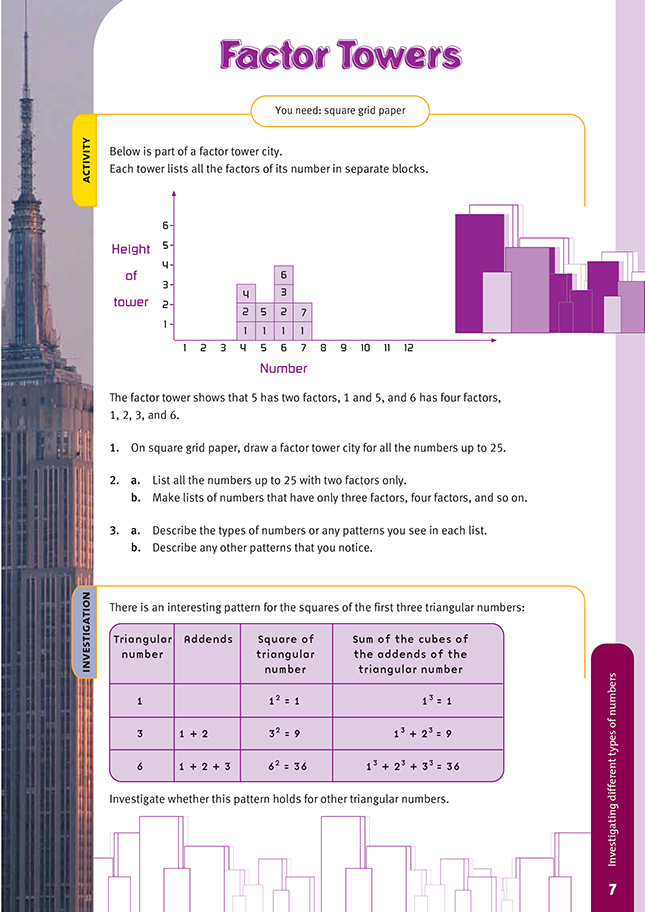This is a level 5 number activity from the Figure It Out series. It relates to Stage 8 of the Number Framework.
A PDF of the student activity is included.
Click on the image to enlarge it. Click again to close. Download PDF (173 KB)
investigate common factors
investigate patterns involving powers
FIO, Level 4+, Number, Book Six, Factor Towers, page 7
Square grid paper
This is a good activity for the students to work in pairs to find and discuss patterns. The real fascination with the activity will probably emerge in question 3, where the students find patterns in the lists of numbers and factors. They may notice, for example, that the numbers with only two factors are all the prime numbers (which makes sense when they think about it). They may also notice that the numbers with three factors are all square numbers and that the five-factor number (16) is also a square number. The students could investigate how many factors the next square number (36) has. (It has 9.) They may notice that in the case of numbers with four factors, the first three always multiply together to give the fourth factor. For example,
with 15, the factors are 1, 3, 5, and 15 and 1 x 3 x 5 = 15.
Investigation
The students will hopefully be intrigued by the relationship between squares of triangular numbers and cubed numbers. This is an investigation into pure number because there is no ready way that the relationship can be modelled with materials. The students will need to list some of the other triangular numbers to tackle
this. If they sketch the numbers like this:
they should see that the fifth triangular number is 15. They could write the relationship between the square of this number and cubed numbers like this:
(1 + 2 + 3 + 4 + 5)2 = 152
= 225
= 13 + 23 + 33 + 43 + 53.
Again, to find the cube of the higher numbers (such as the 4 and 5), the students could simply use the constant function on their calculator (that is, 4 x = = or 4 x x = = ) or the xy button on a scientific calculator, as was suggested in an earlier activity.
Answers to Activity
1. Practical activity. Your factor tower city should be similar to this one:
2 . a. 2, 3, 5, 7, 11, 13, 17, 19, 23
b. Three factors: 4, 9, 25
Four factors: 6, 8, 10, 14, 15, 21, 22
Five factors: 16
Six factors: 12, 18, 20
Eight factors: 24
3. a. Responses will vary. They could include:
The numbers with two factors are prime numbers. The numbers with three factors are square numbers. For the numbers with four factors, the first three factors (in order) multiply together to give the fourth factor. For example, factors of 10 are 1, 2, 5, and 10. 1 x 2 x 5 = 10
b. Responses will vary. They could include:
All numbers have at least 1 and themselves as factors.
Numbers with an odd number of factors are square numbers.
24 has the most factors (8), and 1 has the least (1).
investigation
Yes, it does. For example, 102 = 100, which is the same as 13 + 23 + 33 + 43 = 100.


